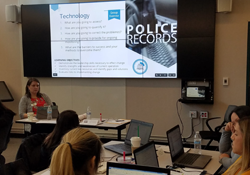FEBRUARY 2021

Consider what happened in Portland, Oregon when the Regional Justice Information Network (RegJIN) project failed after just a couple of years when the 40+ agencies who planned on sharing a new CAD/RMS system pulled out of the project, $12 million wasted dollars and countless news articles on the matter, later.
7 Costly Mistakes to Avoid
ONE: Non-participative project management. A project which is led and solely managed by executive or command level staff without any input from anyone else is doomed for failure. There are three reasons this occurs including: 1) Someone at the top wants total control; 2) There is a lack of trust; 3) The employees who normally should be participating in the project, those who represent the various functions of the agency (records, dispatch, patrol, investigations, etc.) are not considered as having the expertise needed to be a part of the project.
Whatever the reason may be, the notion of not obtaining input from the people who will be using the system daily is quite counterintuitive. Their input should be vigorously sought out and considered.
TWO: Selecting the wrong system (and vendor). In early 2019, during one of our seminars, attendees began discussing CAD/RMS systems. There were about 25 agencies in the room. One of them indicated they were close to purchasing a new system after a lengthy procurement process and mentioned the name of the chosen vendor. Upon doing so, over half the room gasped upon mere mention of the vendor’s name. What followed was the revelation that over half of the seminar attendees used the same system and all of them were very displeased with it. System crashes, problematic updates, poor vendor support. The feedback was overwhelmingly and consistently negative.
The department was about to spend over $1M on a system that had been sold to many other uninformed buyers, all of whom paid a dear price in more ways than one. This lack of due diligence happens all too often; a reliance on what the vendor itself says about…itself, without asking around.

The references provided by vendors in their proposals will naturally be pre-selected and thus positive. It is important to really dig and contact many other departments which use the systems you are considering.
Lastly, remember you are selecting a company as much as you are selecting a product. Look beyond the software and evaluate the vendor’s sustainability as a business, their responsiveness to requests for support and ability to service your department on-demand, when you need them.
THREE: An outdated RFP. An RFP is but one, albeit the most important, element of the procurement process. The purchasing process should include the RFP and scoring of vendor proposals, vendor demonstrations, reference checks, and a hands-on computer lab in which the vendor arranges for personnel to try the system themselves.
It is the RFP itself however that so often misses the mark, written in a manner which does not correctly reflect the needs of the agency. Writing a document that forces vendors to bend how their system functions instead of inviting them to propose how their current solution meets your needs is the wrong approach. This was perhaps the root cause of failure in the RegJIN project.
Including a list of thousands of system specifications opens the door for failing to see the big picture and whether the system really is a good fit. Checking the box with binary yes or no options does not provide true insight to you, the buyer, about the whole package. After finishing this article, come back to this one for information about good and bad RFPs.
FOUR: No negotiation. Ask for a lower price and you will likely get it. However, price can be a moving target since contract negotiations often include requests for this and that. Be careful not to exceed what you asked for in the original RFP but be confident in negotiating the cost down.
FIVE: Incomplete budgeting. The costs for software should never be looked at through the lens of one-time out-of-pocket expenditures. The costs will be ongoing and vendors make their money on what they charge for annual support. Be sure to build out anticipated 3, 5 and 10-year costs to include expenses for the software itself, support, hardware, interfaces, storage, peripherals, and personnel hours associated with system upkeep and administration.
SIX: Insufficient project planning and management. A system replacement requires extensive planning and project management before, during and after implementation. This is not a project to be taken lightly, without a plan or without a team. Such projects require drafting the rules of engagement, written via a Project Charter and a Project Plan which spells out the project’s chain of command and change, communication and risk management procedures.
The project team should include members with assigned roles to ensure project continuity and successful execution of the Project Plan (assignment of tasks, follow-up and documentation). They include finance, training, technology, operations, command and procurement representatives. Regular meetings and collaboration throughout the project must continue, given priority relative to other areas of responsibility.
SEVEN: Lack of experience. Law enforcement is currently experiencing high-turnover, resulting in the loss of institutional experience and knowledge. Many departments no longer have staff who have been through these kinds of projects and thus, there is a need for guidance. Such guidance can be obtained through research and self-education, training, and/or consulting services.
If you take the do-it-yourself approach, get online and research the readily available law enforcement technology and project management guides.
Additionally, PRI provides the 2-day course, CAD/RMS Procurement and Project Management and encourages you to attend. Students are provided with project/RFP templates to get a big head start. We also specialize in procurement and project management services.
See how we can help here with our CAD/RMS project services.

